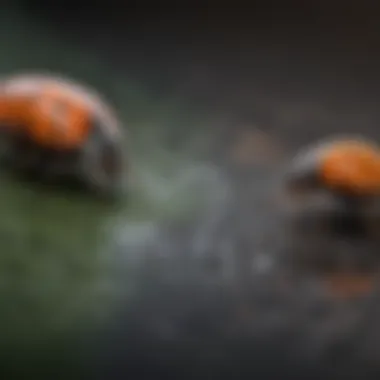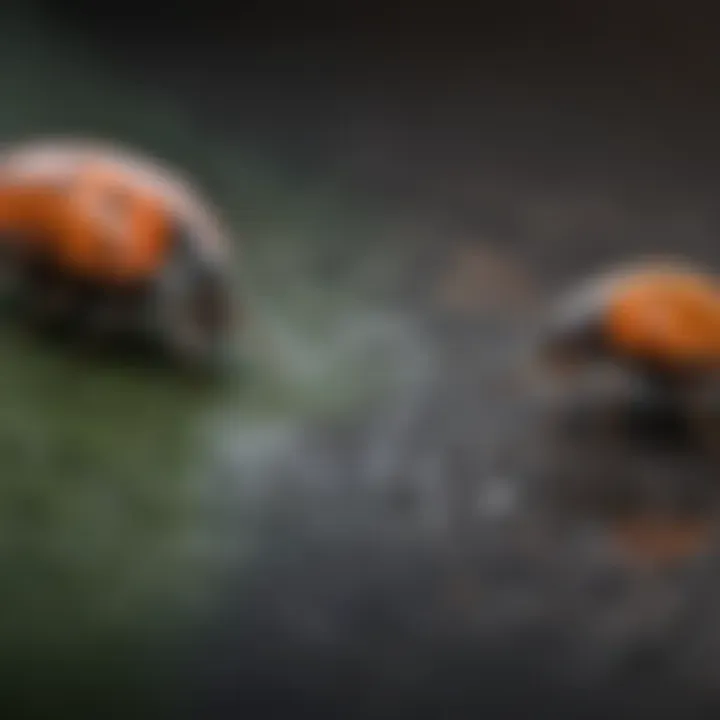Exploring Natural Bug Repellents for Your Home


Intro
Natural pest control is becoming increasingly relevant in today's eco-conscious society. Many homeowners, tired of synthetic chemicals and their adverse effects, are turning towards natural house bug repellents. Whether it is for family health or environmental concerns, natural methods offer practical solutions to deter unwanted visitors without the risk associated with harsh substances.
In this article, we will discuss various homemade strategies and key ingredients proven to repel bugs. We will also explore the science behind these natural solutions. This examination will provide useful practical applications and recipes suitable for any household. Throughout this discussion, we will highlight the limitations of natural repellents, to ensure homeowners can make informed choices compared to synthetic alternatives.
By understanding the fundamentals of natural bug repellents, readers can create a pest-free environment that is safe and effective. Simple measures can help keep homes comfortable and free of insects.
"Natural repellents blend safety with effectiveness, making them ideal for conscientious living."
The insights gained here aim to empower readers with knowledge. Thus, this article serves as a comprehensive guide to navigating the world of natural bug repellents.
Understanding Pests in the Home
Understanding pests within the home environment is crucial for any effective pest management strategy. This knowledge offers insight into the various species that may invade living spaces and the underlying reasons for their presence. By recognizing common pests, homeowners can better prepare and implement appropriate natural repellent solutions. Each pest presents distinct challenges and requires attentive methods for control.
Common Household Pests
Households often face challenges from several species of pests. Among these, ants, spiders, mosquitoes, and flies are the most notorious for their ubiquity and potential impacts on the home environment.
Ants
Ants are social insects known for their complex colonies and communication systems. They often invade homes in search of food. The presence of ants can signal the need for immediate action, especially if they infest food sources. Their ability to carry and transport food makes them effective in scavenging. On the positive side, certain natural repellents can deter ants effectively without harm to the environment. However, once established, ant colonies can be challenging to eliminate fully.
Spiders
Spiders are often misunderstood pests; while many can be beneficial, controlling insect populations, they are also frequently unwelcome in homes. Some species are venomous and pose a risk to human health. Natural repellents can keep spiders away without killing them, as they can help in controlling other pest species. However, a well-kept home can naturally reduce their presence, mitigating the need for repellent use.
Mosquitoes
Mosquitoes are primarily drawn to humans due to the carbon dioxide we exhale and our body heat. They can transmit serious diseases such as West Nile virus and Zika. Consequently, their presence raises significant health concerns. Natural repellents, featuring essential oils, can provide a defensive line against these pests, especially during warmer months. Unfortunately, efficacy can vary based on the formulation.
Flies
Flies, particularly houseflies and fruit flies, can be a major nuisance. They are attracted to food waste and can carry pathogens that may contaminate food surfaces. Natural repellent strategies, including vinegar traps and oil sprays, can effectively curb their population. However, flies reproduce very quickly, making it essential to address infestations promptly to prevent a larger issue.
The Impact of Pests on Health and Environment
Pests can have significant negative impacts not only on household comfort but also on health and ecological balance. Understanding these impacts emphasizes the necessity for effective pest management strategies.
Health Risks
The presence of pests can pose various health risks. Insects such as cockroaches and mosquitoes can trigger allergies and spread diseases. House dust mites and other pests may lead to respiratory issues. By addressing pest control comprehensively, homeowners can protect their health and reduce exposure to allergens and pathogens.
Ecosystem Consequences
Pests also affect the ecosystem within homes. For example, the overuse of chemical insecticides can harm beneficial insects and disrupt the natural food chain. Natural pest control methods can support a balanced ecosystem while ensuring that common pests do not jeopardize human health. These methods often promote biodiversity rather than suppressing it.
Understanding pests is vital for creating a pest management strategy that is both effective and environmentally friendly.
Defining Natural Bug Repellents
Understanding natural bug repellents is essential in the context of maintaining a pest-free environment. These products stand out due to their use of natural ingredients, which are often less harmful to both humans and the ecosystem when compared to synthetic alternatives. It is crucial to define what classifies as a natural repellent, as it sets the foundation for discussing their effectiveness, safety, and practical applications.
Natural repellents have several benefits. They can minimize exposure to toxic chemicals commonly found in synthetic repellents, reducing health risks for pets, children, and individuals with sensitivities. Furthermore, they often harness the power of nature, utilizing essential oils and other plant-based ingredients, which can be eco-friendly. In an age where people increasingly prioritize sustainability, understanding what constitutes a natural repellent becomes vital.
What Constitutes a Natural Repellent?
A natural bug repellent is typically made from plant-based or naturally sourced materials that deter pests without harmful side effects. Common components include essential oils, vinegar, and herbal mixtures. Essential oils, such as peppermint and lavender, are prominent for their strong fragrances that can repel various insects. These ingredients interact with pests' sensory receptors, causing confusion or discomfort, hence leading them to avoid treated areas.
The ingredients used in natural repellents vary widely and often depend on the target pest. Raspberry leaf, for instance, is effective against mosquitoes, while neem oil can deter a range of unwanted insects. Each natural repellent has a unique combination, requiring users to tailor their choices to their specific pest issues.


Comparative Analysis with Chemical Repellents
Natural bug repellents can be viewed through the lens of comparison with their chemical counterparts. This analysis sheds light on important aspects such as safety and effectiveness.
Safety Considerations
In discussions of safety considerations, natural repellents showcase a marked advantage. Unlike chemical repellents, which can carry significant health risks — including skin irritation and respiratory problems — natural options are perceived as being milder. Not only do they often lack harmful pesticides, but they also keep indoor air quality intact, thus supporting a healthier living environment.
A notable characteristic of natural repellents lies in their minimal environmental impact. Many are biodegradable and do not contribute to pollution. This unique feature makes them preferable for eco-conscious consumers looking to protect their homes and the earth simultaneously.
Effectiveness
Effectiveness is another crucial aspect where natural repellents often face scrutiny. While some users may question whether they work as well as synthetic alternatives, studies have shown that certain natural repellents can be remarkably effective. For example, essential oils like citronella have long been recognized for their ability to repel mosquitoes effectively.
The effective lifespan of natural repellents can differ. They might require more frequent application compared to traditional chemical repellents, especially under high-exposure conditions like heavy rainfall or prolonged outdoor use. However, their natural origin can be a comforting feature for those wary of chemical toxicity in their homes.
"Natural repellents, while requiring possibly more frequent application, prioritize health and sustainability, setting a new standard for pest control."
Key Ingredients for Natural Bug Repellents
The choice of ingredients is crucial in creating effective natural bug repellents. Unlike chemical alternatives, natural ingredients often present a gentler approach to pest control. These repellent strategies harness the power of naturally occurring compounds that can deter unwanted insects without posing significant risks to human health or the environment. Understanding the specific elements that contribute to the effectiveness of natural repellents aids homeowners in making informed choices about pest management in their domestic environments.
Essential Oils
Essential oils are a popular choice for natural bug repellents due to their potent insect-repelling properties. Each type of essential oil has its unique benefits, making them suitable for different purposes in pest control.
Peppermint Oil
Peppermint oil is well known for its strong aroma, which is generally off-putting to many common pests, such as ants and spiders. Its primary characteristic is its intense menthol scent, which can interfere with an insect’s ability to detect pheromones. The refreshing smell also provides a pleasant fragrance in the home. However, its effectiveness can decrease when used in a diluted formula, making concentration critical to its success.
Lavender Oil
Lavender oil stands out for its pleasant scent and calming properties. It is effective in repelling moths, mosquitoes, and even flies. This oil's key characteristic as a repellent lies in its floral aroma, which can mask the scents that attract pests. Additionally, it offers the benefit of enhancing indoor air quality. Nonetheless, the effectiveness of lavender oil can vary depending on the concentration and application method used.
Eucalyptus Oil
Eucalyptus oil is particularly effective against mosquitoes and flies. Its primary feature is its strong, pungent scent, which repels these pests effectively. This oil is often considered a beneficial choice for individuals seeking to prevent insect bites outdoors. The downside is, its strong smell may not be suitable for all indoor environments. Some may find it overwhelming, which limits its use in closed spaces.
Vinegar and Water Solutions
Vinegar solutions can serve as an effective and inexpensive base for homemade bug repellents. The acetic acid in vinegar can disrupt the sensory receptors of insects, leading to a natural deterrent effect. A mixture of vinegar and water typically works well against ants and spiders. Mixing vinegar in different ratios enables flexibility depending on the concentration desired, allowing for customization based on specific pest issues.
Herbal Mixtures
Herbal mixtures leverage the natural insect-repelling properties of various herbs. They are useful not only in repelling bugs but also in promoting a fragrant home environment, fostering a sense of calm.
Rosemary
Rosemary is well-regarded for its strong aroma which repels mosquitoes and other insects effectively. The key characteristic of rosemary as a repellent is its potent scent, which can be particularly useful in outdoor settings. However, its effectiveness might not be as pronounced in heavily infested areas unless used in large amounts.
Basil
Basil is another herb that contains compounds effective against flies and mosquitoes. Its fresh and vibrant aromatic presence makes it a popular choice in home gardens. The unique feature of basil lies in its culinary applications, offering dual benefits as a pest repellent and a kitchen herb. However, its effectiveness is best maintained when used fresh instead of dried.
Thyme
Thyme is noted for its strong floral fragrance. It can effectively deter mosquitoes as well. The strength of thyme oil in repelling pests makes it a popular choice for natural repellent formulations. One downside is that its properties may diminish when exposed to air for prolonged periods after formulation, so fresh use is preferred for maintaining potency.
"Natural ingredients are often more environmentally friendly options when compared to synthetic chemicals, providing safer alternatives for pest control."
In summary, the selection of key ingredients in natural bug repellents plays a significant role in their efficacy. A combination of essential oils, vinegar solutions, and herbal mixtures creates a robust defense against household pests, while offering various benefits and considerations for practical use.


Formulating Natural Bug Repellents
When considering ways to keep our homes pest-free, formulating natural bug repellents presents a compelling alternative to chemical solutions. This section will dig into why making your own repellents is significant, emphasizing the benefits such as safety, cost-effectiveness, and the ability to customize ingredients based on specific household needs. Natural formulations often sidestep the harsh chemicals found in commercial products, which can be harmful to both health and the environment, catering to an eco-conscious mindset.
Basic Recipes Using Essential Oils
Essential oils are a cornerstone in creating effective natural bug repellents. Their strong odors and chemical compositions repel various pests without the use of synthetic chemicals. When creating bug repellents with essential oils, you should consider the following:
- Peppermint Oil: Known for its strong scent, peppermint oil is effective against ants and spiders. Mix 10-15 drops with water in a spray bottle for a simple yet effective solution.
- Lavender Oil: This oil is not only pleasing to humans but repels moths, fleas, and mosquitoes. Combine 15 drops of lavender oil with a cup of water and a teaspoon of dish soap to enhance its sticking power.
- Eucalyptus Oil: Particularly effective against mosquitoes, eucalyptus oil can be combined with a carrier oil or water before application to the skin.
To create a versatile natural bug repellent, you can mix equal parts of water and witch hazel with a few drops of your chosen essential oils. Shake well before each use.
Vinegar-Based Spray Recipes
Vinegar is another efficient ingredient for DIY bug repellents. Its acidic nature disrupts the systems of many pests without endangering humans or pets. Some popular vinegar spray recipes include:
- All-Purpose Vinegar Spray: Combine one part vinegar with one part water in a spray bottle. This solution can deter ants, spiders, and even fruit flies. The smell dissipates quickly but provides immediate repulsion.
- Herbal Vinegar Spray: Infuse vinegar with herbs like rosemary, thyme, or basil for a scented repellent. To create this, fill a jar with herbs, top it with vinegar, seal it, and let it sit for about two weeks. Strain and use as a strong bug repellent.
Herbal Infusions and their Applications
Using dried herbs offers another homegrown approach to pest control. Some key herbs include:
- Rosemary: Besides being a culinary staple, rosemary is a great natural repellent for mosquitoes and flies. It can be infused in oil or made into a tincture for various applications.
- Basil: Known for its aromatic properties, basil can keep house flies away. Brewing a tea from fresh or dried basil leaves can create a fragrant solution for indoor use.
- Thyme: Useful against a wide range of pests, thyme can be used similarly to rosemary in oils or teas.
Infusions can be sprayed around entry points in the home or used to wipe surfaces that pests frequent. By utilizing these ingredients, homeowners can tailor natural repellents to fit their environments, resulting in a more sustainable and effective pest management strategy.
Practical Methods for Application
Applying natural bug repellents effectively is crucial for keeping household pests at bay. Proper application techniques ensure that these natural solutions work optimally. Utilizing each method correctly can enhance the effectiveness of the ingredients used, thereby reducing the nuisance caused by unwanted insects. Moreover, understanding different application methods can help in tailoring strategies to specific environments, whether in kitchens, gardens, or living areas.
Spraying Techniques
Spraying remains one of the simplest and most effective methods for applying natural bug repellents. A well-prepared solution that includes essential oils, vinegar, or herbal extracts can be stored in a spray bottle for easy use. This method allows for targeted application, which is especially useful in areas where pests are most prevalent.
When executing this technique, a few steps should be considered:
- Choose the Right Bottle: Use dark glass bottles to protect the integrity of the oils.
- Mix Properly: Combine water with essential oils or vinegar in a precise ratio; generally, a mix of one part vinegar to three parts water works well for many applications.
- Test Surfaces: Always test a small area before spraying extensively to ensure there’s no adverse reaction on surfaces.
- Focus on Hotspots: Concentrate on areas where pests are often seen.
For example, a peppermint oil solution may effectively deter ants and spiders, while a vinegar solution can work well for flies.
Using Diffusers and Potpourri
Diffusers and potpourri are additional innovative methods to disperse natural scents throughout a home. This technique not only serves to repel insects but also adds a pleasant fragrance to indoor spaces, appealing to both aesthetics and functionality.
Considerations when using diffusers:
- Essential Oils Selection: Choose oils known for their insect-repelling properties, such as eucalyptus or lavender.
- Placement: Position diffusers in high-traffic areas to maximize effectiveness.
- Regular Refill: Essential oils evaporate over time, so frequent refills are necessary to maintain potency.
Potpourri can be made from dried herbs and essential oils. Place it in decorative bowls around the house to achieve similar results. These methods serve dual purposes of enhancing ambiance while conserving a pest-free environment.
Creating Bug-Repelling Household Products
Integrating natural repellents into everyday household products is an innovative approach to pest management. This includes the development of scented cleaning solutions, laundry detergents, or even bathroom sprays that inherently act against bugs due to their ingredients.
To create effective bug-repelling products:
- Combine Cleaning Solutions: Add a few drops of essential oils like tea tree or lemon to your regular cleaning supplies.
- DIY Laundry Additives: Add essential oils during the rinse cycle for clothes that are less likely to attract insects.
- Craft Room Sprays: Combine vinegar with essential oils to form a versatile spray that can be used on various surfaces.
"Natural household bug repellents do not just keep the pests away; they also contribute to a healthier indoor environment."
By using these practical application methods, homeowners can significantly reduce the presence of pests in a manner that aligns with eco-friendly philosophies.


Limitations and Considerations
When discussing natural house bug repellents, it is crucial to outline the limitations and considerations that accompany their use. Many homeowners seeking chemical-free solutions often overlook potential drawbacks. Understanding these limitations can guide effective pest management while aligning with eco-friendly practices.
Efficacy of Natural Repellents
Natural bug repellents, while often safer for the environment and human health, do not always provide the same level of effectiveness as their synthetic counterparts. The efficacy of these natural solutions can vary widely based on several factors:
- Repellent Ingredients: Different essential oils and natural substances possess varying degrees of repellent qualities. For instance, peppermint oil may deter ants but might not be effective against mosquitoes.
- Concentration Levels: The effectiveness can be impacted by the concentration of active ingredients in a formulation. Higher concentrations tend to yield better results; however, they may also increase the risk of irritation or allergic reaction in sensitive individuals.
- Application Consistency: Regular and proper application is vital. Natural repellents often dissipate more quickly than chemical ones, necessitating frequent reapplication, particularly after rain or heavy cleaning.
Homeowners should be prepared to experiment to find the right combination and application method that works best for their specific pest problems.
Potential Allergens and Sensitivities
With natural ingredients comes the consideration of allergens and sensitivities. While many people prefer natural repellents, some ingredients can provoke allergic reactions.
- Essential Oils: Oils like lavender and eucalyptus are generally safe but can cause skin irritations in some individuals. A patch test is advisable before applying any new formulation widely.
- Vinegar and Herbal Mixtures: Though often deemed harmless, vinegar's acidity may irritate sensitive skin. Similarly, herbs such as rosemary may trigger allergic responses.
It is essential for users to be aware of their sensitivities when using these products. Keeping a close watch for any adverse reactions is a prudent practice. In cases of known allergies, thorough research into the ingredients used in these natural repellents is critical.
"Natural does not always mean safer, awareness of possible allergies is key to effective pest management."
By acknowledging the limitations and weighing the potential allergens against their benefits, homeowners can make informed decisions when choosing natural bug repellents.
Long-term Pest Management
Long-term pest management is essential for maintaining a pest-free home environment. It shifts the focus from short-term solutions to sustainable strategies that effectively control pest populations over time. This approach takes into account the life cycle of pests, the environment, and the habits of homeowners. The benefits are not only limiting pest occurrences but also promoting a healthier living space by minimizing the use of harmful chemicals.
Integrated Pest Management Strategies
Integrated pest management (IPM) is a comprehensive approach that combines multiple strategies to control pests naturally and safely. Some key components include:
- Monitoring: Regularly inspect your home for signs of pests. This helps in identifying problems before they escalate.
- Identification: Understanding the specific types of pests enables targeted actions rather than broad-spectrum measures.
- Prevention: Simple steps like sealing cracks, removing food sources, and maintaining a tidy environment can greatly reduce pest attraction.
- Cultural Controls: Modify practices that encourage pest infestations, such as overwatering plants that create favorable conditions for pests like mosquitoes.
- Biological Controls: Introducing beneficial insects, like ladybugs, can help manage aphid populations, providing a natural balance.
- Chemical Controls: In some cases, the use of natural insecticides, as discussed in earlier sections, can be applied selectively and minimally.
By combining these strategies, homeowners can create an adaptable plan suitable for their specific situations, reducing reliance on chemical solutions.
Creating an Eco-friendly Home Environment
Creating an eco-friendly home environment involves making conscious decisions that not only deter pests but also promote overall sustainability. Here are some effective actions:
- Use of Natural Materials: Opt for natural building materials and furnishings that are less likely to attract pests.
- Cleanliness: Regular cleaning routines minimize food sources for pests. Pay attention to areas like under the fridge and inside cabinets.
- Gardening Practices: Implement organic gardening techniques, such as companion planting, which can deter pests naturally.
- Energy Efficiency: Energy-efficient solutions, like double-glazing windows, can help reduce pest access to your home while saving on energy costs.
- Sustainable Practices: Composting and recycling can contribute to a healthier ecosystem, attracting beneficial insects instead of pests.
These eco-friendly practices not only contribute to pest management but also align with broader environmental goals, such as reduced waste and lower chemical use.
By adopting long-term pest management strategies and fostering an eco-friendly home, homeowners can significantly enhance their living environments, creating spaces that are both comfortable and sustainable.
In summary, integrating natural pest repellents with long-term management strategies ensures effective control of pest populations without resorting to chemicals. This approach is increasingly relevant for homeowners seeking harmony between pest control and environmental health.
The End
The conclusion of this article emphasizes the significance of natural house bug repellents in contemporary pest management practices. As more individuals become aware of the impact that chemical solutions have on their health and the environment, a shift towards natural alternatives is increasingly happening. Natural repellents offer a multifaceted approach to pest control that aligns with a healthier lifestyle and sustainable practices.
When discussing the future of natural pest control, it is crucial to recognize several important elements. Firstly, the growing body of research surrounding ecological interactions enhances our understanding of how natural ingredients deter pests effectively. Homeowners can harness these insights to create effective and safe environments.
Secondly, opting for natural repellents fosters better indoor air quality. Many conventional pesticides release harmful fumes that compromise the comfort and health of occupants. In contrast, natural solutions usually do not yield the same level of toxicity. This aspect alone suggests that families may greatly benefit from avoiding harsh chemicals.
The Future of Natural Pest Control
The future landscape of pest control is shifting towards integrating natural solutions effectively. Innovations in extraction methods and formulation techniques promise an increase in the potency of natural ingredients like essential oils, making them more accessible and effective. Homeowners interested in long-term solutions are likely to reduce reliance on synthetics, as they discover new recipes and strategies for insect deterrence.
Incorporating more natural pest control practices into mainstream housekeeping is another trend that may emerge. This could lead to the development of household products with natural bug-repelling properties. For instance, furniture cleaners, fabrics, or paints infused with natural repellents could evolve as appealing options.
"Natural pest control is not merely a trend; it promises a healthier coexistence with our environment."
Furthermore, consumer preferences are pivotal in shaping product offerings. Companies that prioritize sustainability and eco-friendliness will likely see increased demand. This shift means that innovations focusing on effectiveness without compromising health will come to the forefront.
In summary, the future of natural pest control seems promising. By understanding the benefits of these methods and remaining open to new developments, homeowners can enrich their living spaces while minimizing environmental impact.















